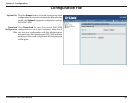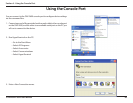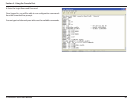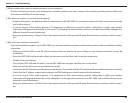
91D-Link DAP-2690 User Manual
Appendix A - Technical Specications
Technical Specications
Standards
• IEEE 802.11a
• IEEE 802.11b
• IEEE 802.11g
• IEEE 802.11n
• IEEE 802.3
• IEEE 802.3u
• IEEE 802.3ab
• IEEE 802.3af
Network Management
• Web Browser interface
HTTP
Secure HTTP (HTTPS)
• AP Array
• Central WiFiManager
• SNMP Support
Private MIB
• Command Line Interface
Telnet
Secure SSH Telnet
Data Rates*
For 802.11a:
• 54, 48, 36, 24, 18, 12, 9, and 6 Mbps
For 802.11b:
• 11, 5.5, 2, and 1 Mbps
For 802.11g:
• 54, 48, 36, 24, 18, 12, 9, and 6 Mbps
For 802.11n : HT20/HT40
• 144.4/300, 130/270, 117/243, 104/216, 78/162, 66/135, 58.5/121.5, 52/108, 39/81,
26/54, 19.5/40.5, 12/27, and 6.5/13.5 Mbps
Security
• WPA™ Personal/Enterprise
• WPA2™ Personal/Enterprise
• WEP™ 64-/128-bit
• SSID Broadcast Disable
• MAC Address Access Control
*Maximum wireless signal rate derived from IEEE Standard 802.11g, 802.11a and
802.11n specications. Actual data throughput will vary. Network conditions and
environmental factors, including volume of network trac, building materials and
construction, and network overhead, lower actual data throughput rate. Environmental
conditions will adversely aect wireless signal range.
**Please note that operating frequency ranges vary depending on the regulations of
individual countries and jurisdictions. The DAP-2690 isn’t supported in the 5.25~5.35
GHz and 5.47 ~ 5.725 GHz frequency ranges in some regions.
Wireless Frequency Range
• 2.4 to 2.4835 GHz and 5.15 to 5.85 GHz**
Operating Voltage
• 48V/0.5A Power Adapter or 802.3af PoE
Radio and Modulation Type
For 802.11a/g/n:
BPSK, QPSK, 16QAM, and 64QAM with OFDM
For 802.11b:
DQPSK, DBPSK, DSSS, and CCK
Operating Frequency*
For 802.11a:
5.15 ~ 5.85 GHz
For 802.11b/g:
2400 ~ 2483.5 MHz ISM band
For 802.11n:
2.4 GHz Band: 2.4 ~ 2.4835 GHz
5 GHz Band: 5.15 ~ 5.85 GHz
Dipole Antenna
4dBi Gain @2.4 GHz
6dBi Gain @5 GHz
LEDs


















